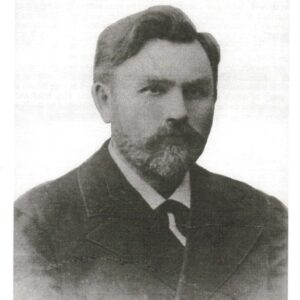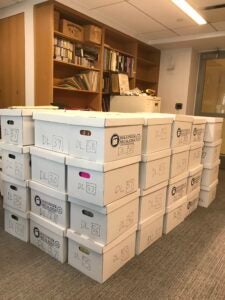David Lefkowitz and Biographies in the Archive
From March through June of 2025, I worked alongside Cantor David Lefkowitz, the emeritus cantor at Park Avenue Synagogue (PAS) in Manhattan, to prepare his personal library for donation to two archives. David’s collection of synagogue documents and memoranda would go to the American Jewish Archive in Cincinnati, and his collection of music manuscripts to YIVO in New York City. Working closely with David a few days a week over the course of these months, I got to know him better personally, which was a pleasure, but also opened a window for me to take a good look at the relationship of an individual and their archive. For a cantor at a major institution, this relationship is far from purely personal and nostalgic. The archive of this one person involves many actors across an international sphere of Jewish life and engages multiple periods in history.
In the case of David’s music collection, his holdings were actually the collection of the last century of cantors at PAS, as well as the musical manuscripts and ephemera belonging to his father Cantor Jacob Lefkowitz (1913-2009). It is worthwhile to note here that David and I are cousins. David is first cousin to my grandfather Cantor Jacob Konigsberg (1921-2007). My grandfather cited his uncle Jacob, who was only a few years older than him, as his first teacher and one of his earliest inspirations in getting excited about khazones (cantorial art music). Although our families are tightly linked by profession and lineage, working together on the archive project was the first time David and I spent any extended time together.
Park Avenue Synagogue has a unique position as an economically and politically elite center of Jewish American life and its musical offerings reflect this status. Cantors at Park Avenue Synagogue have typically had very long tenures (somewhat unusual in the often cut throat world of cantorial hirings and firings). Each cantor has set their own musical agendas that reflected the aesthetics and the cultural aspirations of the community they served in their day. David served at PAS from 1976-2009. His immediate two predecessors also had long terms. Cantor Abraham Sukoenig served from 1914 to 1932, and Cantor David Putterman from 1933 to 1976. Sukoenig was a famous vocal artist in the German Reform tradition, performing music by Lewandowski, Sulzer and Naumbourg, and other Jewish composers in the romantic classical style. Putterman had a vision of PAS as the center of a new era of Jewish American classical music. He instituted an ambitious program of commissions of newly composed pieces for the Friday Evening Service, working with prestigious composers such as Leonard Bernstein and David Diamond, among others. The current cantor, Ari Schwartz, continues the musical focus the institution while putting his own stamp on this musical legacy. Unlike his predecessors, however, Schwartz’s music collection is almost entirely digital and leaves practically no physical footprint for future archivists to touch.
David’s musical library is a kind of palimpsest, showing the multiple layers of institutional history. It includes hundreds of pages of handwritten choir scores and arrangements of nineteenth century Jewish synagogue music in the German tradition, countless transcriptions of nusakh (traditional melodies for the prayer services) written out by many different cantors, recitatives composed by cantors famous and obscure, and original manuscripts of Jewish composers including Kurt Weill and Bernstein. His archive also includes “Service Schedules,” set lists that show what pieces of music were sung for each element of the liturgy in almost every Shabbat service from 1978 until 2009.
David Lefkowitz’s tenure at PAS followed the innovations instated by Putterman in commissioning high profile new music for the synagogue. David’s approach was inflected by his interest in Eastern European Jewish music and life, reflecting his commitment to the musical legacy of his father and the immigrant milieu he grew up in. In addition to the commissions for the Friday Evening Services that typically featured newly composed music, David added an annual Shabbat morning concert service that would feature classics of Jewish synagogue music. These special Shabbat services served as a workshop for David’s interest in the work of late nineteenth century Russian Jewish composers, especially the work of David Nowakowsky (1848-1921). Nowakowsky was the choir master at the Broder Synagogue in Odessa, where he worked with the well-known Cantor Pinchas Minkovsky (Minkovsky will be familiar to readers of this blog series).
Nowakowsky’s music became a singular focus of David Lefkowitz’s research and performance during the decades of his cantorial post at PAS. I would venture to say that David looked to Nowakowsky as a signal musician indicating a pathway for artists like himself who sought to find a musical path that could draw on both Jewish religious folklore and the European classical tradition. David described to me one of his first interactions with Nowakowsky’s scores. He found a choral introduction to the Shabbat Minchah service. It began with a fugue choral piece. Reading through the piece, he realized that the theme of the fugue was the Jewish folk song “Eliyahu hanavi,” the ubiquitous song for the Havdala ceremony that ends the Sabbath that he had grown up singing with his family. Tears came to his eyes in the moment of recognition of this rippling of the circle of history.
In a videotaped interview, David described for me how he acquired Nowakowsky’s manuscripts. I will devote the rest of this brief blog post to the story of this one element of David’s archive.
What David describes here, entirely from memory and in impressive detail, is a story of textual transmission in a period of Jewish political upheaval and migration, inflected by the personalities of artists.
David Nowakowsky was born in Malin, a small town outside of Kiev, and was orphaned as a small child. He was a prodigy as a child cantorial choir singer, and at the age of 21 was invited by Nissan Blumenthal to be the choir director at the prestigious Broder synagogue in Odessa. For the next fifty years, Nowakowsky worked as choir director and composer at the Broder, first working with Blumenthal and then, starting in 1891, with Pinchas Minkovksy. His choir was considered one of the finest in Russia. The music he composed reflected the unique cultural position of the Broder community, a synagogue founded by German speaking Jews who had moved to Odessa from the Austro-Hungarian province of Galicia. The tradition of the shul was focused on German culture. The Broder was an early adopter in Russia of the musical reforms of Central European cantors. Nowakowsky continued this tradition, but made subtle transformations reflecting musical norms of Eastern European Jewish tradition, creating a hybrid music that was in dialogue with German romanticism, but made room for the virtuosic cantorial styles associated with the Polish-Russian Jewish vocal idiom.

Having experienced loss of family at a young age, Nowakowsky had a special sensitivity to the position of orphans and would take talented young singers from the Odessa Jewish orphanage under his wing. He was an especially effective leader of children and was able to write sophisticated music for his personally trained boys choir. Among his proteges was Isidore Geller, an orphan who started in the Broder choir as a singer and then later transitioned to become the first organist when the organ was adopted into the synagogue musical performance starting in 1901. Geller immigrated to the United States around 1921 and soon after gained employment as the organist at Park Avenue Synagogue, where he worked with both Cantors Sukoenig and Putterman until his death in 1952.
Geller brought his personal collection of Nowakowsky’s music with him to America and used parts of it in his work at PAS. However, David Lefkowitz did not receive this music directly through his employment at PAS. Apparently, Geller had had an uneven relationship with Cantor David Putterman, who he worked with for decades. At the time of his death, instead of giving Putterman his priceless musical collection, he left it with Cantor Robert Segal of Congregation B’nai Jeshurun, on the Upper West Side of Manhattan, just across Central Park from PAS. Apparently, Geller had a better relationship with his colleague on the West Side.
One day in 1977 a man with a deep voice had an aliyah (the honor of blessing the Torah) during Shabbat services at PAS. After the service, the man introduced himself to David as the cantor emeritus of B’nai Jeshurun. Cantor Segal, seeing his young colleague as someone with potential to make use of Geller’s collection, offered to give David his Nowakowsky materials. This gift had a transformative effect on David’s musical trajectory. He beagan singing Nowakowsky’s music in services beginning in the late 1970s and in 1989 performed an entire service of Nowakowsky’s music. This musical service led directly to connections to the Nowakowsky family.
Some parts of Nowakowsky’s collection underwent a far more dramatic history of being lost and rediscovered during the Holocaust period. Nowakowsky died in poverty in Odessa. During the Holocaust period, his granddaughter and her family were able to smuggle a trunkload of Nowakowsky’s music to a farm in France where the collection was buried in two German ammunition boxes. Members of the family escaped Europe to the United States. The boxes containing the collection were exhumed in 1952 and brought back to America. After the Nowakowsky family became aware of David’s work with their ancestor’s music they reached out to David, establishing a relationship and leading to him acquiring more archival materials. The connection between a living cantor in a thriving institution and the salvaged archival material held by virtue of the persistence of a family and their memory of an esteemed ancestor created the material conditions for a lost body of work to be reactivated in new musical contexts.
Today, the Nowakowsky archive is housed in the YIVO Archive, alongside the massive collection of David’s library. The collection of 61 boxes of music and related documents is probably still sitting in the warehouse at YIVO waiting to be catalogued, but its disposition in the archive is fortuitous and overbrimming with possibilities. The potential energy of many lifetimes of music making is sitting quietly, awaiting the moment when it can bloom in the work of future scholars and artists.

FURTHER READING
Emanuel Rubin, “The Music of David Nowakowsky (1848-1921): A New Voice from Old Odessa,” Musica Judaica XVI (2001-02), 20-52.
https://openpublishing.library.umass.edu/plugins/books/1/format/61/download/
Steven Zipperstein, The Jews of Odessa: A Cultural History, 1794-1881 (Stanford University Press, 1985).